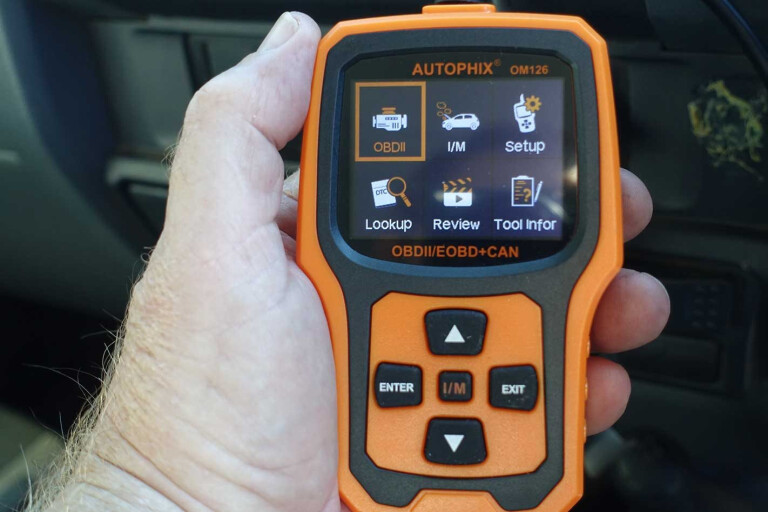
NOT SURE what an OBD reader does, or is?
An OBD reader is an On-Board Diagnostics (OBD) unit that you can plug into the OBD port on any modern vehicle and it will detect any faults, show what fault or code is occurring, and in the better units allow you to erase those codes and faults.
OBD readers come in all shapes and sizes and cover all price ranges from 20 bucks to a few thousand dollars, the latter you’ll find in good, well-equipped service outlets. I’d stay away from the cheap units you’ll find on eBay or the like and go for something that is a bit more effective, reliable and that can, at the very least, erase unwanted codes.

While there are dozens of different code readers and scanners on the market, you need to ensure they are compatible with your vehicle. The Autophix range reviewed here will work with most modern vehicles, but, for example, may not work on Patrols earlier than 2007 and LandCruisers earlier than 2008. It pays to check!
When it comes to the vehicles I own my 2001 Patrol only features an OBD-I port, so luckily the ol’ girl has limited electronics. Our 2005 RAM 2500 in the USA has an OBD-II port, so I have a pretty fancy scanner for it. It’s an expensive unit that not only reads engine fault codes but can also change the boost on the turbo and other performance-enhancing criteria.
On my 2015 79 Series Cruiser, I ended up fitting a fairly expensive ScanGaugeII. This code reader is designed to be connected to the system all the time and, while it can read a host of functions, its main role is to read engine fault codes whenever they develop. However it’s frustrating, as when it throws up a code you have to find what that particular code means and, as there are thousands of codes a vehicle can exhibit, you have to carry a book, a comprehensive list, or have access to the web so you can Google the offending code.

Luckily there is a better alternative, and I’ve been playing around with three different models in the Autophix range of code readers (there’s something like 10 units available in Australia) to see what rocks my boat the most.
The Autophix 3210 is the cheapest and possibly the best model as far as the normal four-wheel driver is concerned, and it communicates with your smartphone once you’ve downloaded the free app.
This unit can stay connected all the time if you like, and it provides a host of info on its ‘dashboard’ screen, which can be customised and have up to eight engine functions monitored. These include Engine Coolant Temperature (ECT), Exhaust Gas Temperature (EGT), engine revs, engine load, air flow, battery voltage and a heap more.
When it comes to reading codes it has a couple of additional advantages over many other units. Apart from being significantly cheaper than a ScanGaugeII, when it comes to reading engine fault codes it not only throws up the detected code but also gives you an idea of what that five-figure code means. Then it gives you the possible causes that could generate such a code, which is a fabulous help in fault-finding and remedying the problem, helping you get back on the road easier and sooner.
.jpg )
It should be noted that all the Autophix units allow you to erase any fault codes generated. In many or most cases that fixes any issues, as vehicles do throw spurious codes at times and these are not an indication of a real fault. But, if the code is regenerated immediately, or soon after you have erased it, it means you have a deeper problem and you need to start looking for the possible causes.
I also tried out the OM126 and the Autophix 9000, both of which are full-mode and updateable scanners meant for fault finding and are not designed to be connected all the time while driving.
I wasn’t so enamoured by the 126 and, while it gave a description of what the fault code meant, it didn’t give a list of possible causes. The 9000 on the other hand did so and is more of a professional unit, while also featuring a bigger colour screen and a battery test function. So, while it’s a bit more expensive, I’d go for that one in lieu of the 126. Still, it’s bloody hard to go past the 3210! It is just so versatile and all you need is a smartphone to pair with it.
For the price of a tank of fuel you can get an Autophix OBD scanner that can save you a lot of heartache and can even save you a service fee or a recovery. You’d be crazy not to have one!
ESSENTIAL INFO
AVAILABLE FROM: www.autophixaustralia.com.au
RRP: $130 (3210 Bluetooth); $150 (OM126); $250 (9000)
WE SAY: Everyone with a modern 4WD needs one of these.

COMMENTS